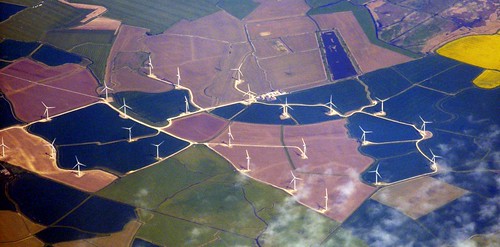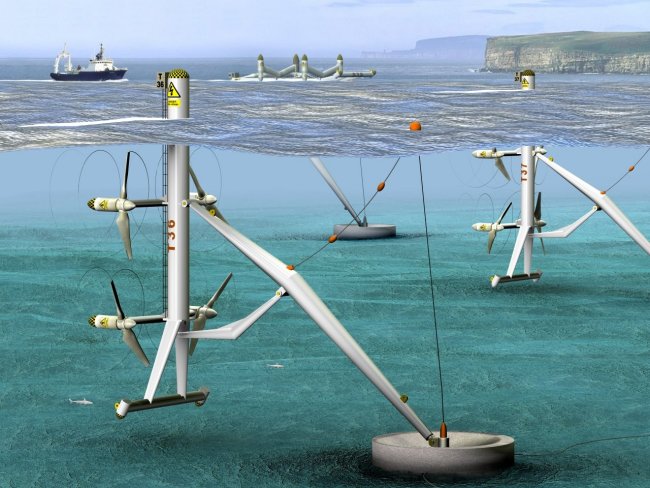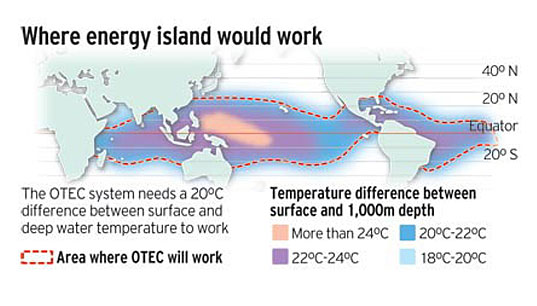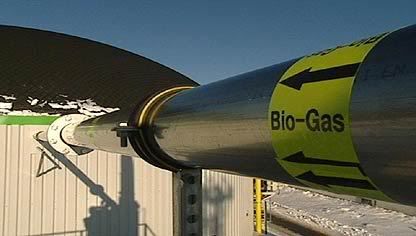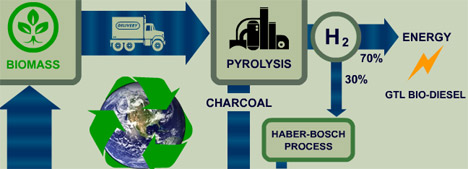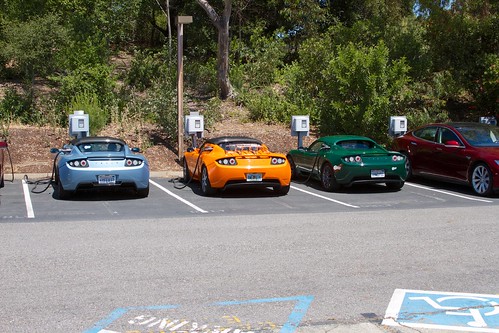Following on my recent post bidding Farewell to The Oil Drum, I'd like to have a look at what I view as our longer term future for energy production and consumption.
As noted in my previous post, for the time being the combination of unconventional oil extraction and the ramping up of extraction of natural gas (from both conventional and unconventional sources) has continued to push the point of peak oil production out into the future, defying the predictions of the more pessimistic peak oil observers. During this period we have seen a boom in the research and development of solutions to help us eliminate our dependency on fossil fuels, which I'll explore in this post.
Solutions can be divided into 3 groups :
- Renewable energy - solar power, wind power, geothermal power, hydro power, ocean energy and biomass derived power (including biofuels)
- Distribution of renewable energy - energy storage and the electricity grid
- Adopting alternatives to oil and other fossil fuels - electric transport, bioplastic, alternatives to fossil fuel based fertiliser and new models for manufacturing, construction and agriculture
Renewable Energy
The graphic below shows the energy available from renewable energy sources annually compared to global energy consumption. The numbers are intended to give a rough idea of relative scale - for any given energy source a wide range of estimates can be found in the literature so the numbers are indicative.
These numbers in some ways understate the amount of energy potentially available (ignoring solar power potential at sea or in space, for example, or wind power at high altitudes or far offshore, or geothermal power deep below the surface of the earth) but still serve the demonstrate that the renewable energy available to us is orders of magnitude larger than our current global energy consumption.
The contribution made by renewable energy to our energy needs is expected to exceed that made by gas (and double that made by nuclear power) by 2016, though progress needs to be accelerated if we wish to create a sustainable energy system.
Solar power
Solar power is the largest energy source available to us, dwarfing all other sources - renewable and non-renewable. Approximately 36,000 Terawatts of power could be captured by land based solar power generation - compared to current global energy use of around 16 TW. As a result, most of the plans floated for shifting to 100% renewable energy (examples include proposals by Mark Jacobson and Stuart Staniford and local plans for countries like Germany and Australia) rely primarily on solar power.
Solar power is not only the largest energy source available to us but it is also the fastest growing energy source, with solar power generation increasing by over 58% in 2012.
There are a number of options for harnessing solar power - power generation using solar photovoltaic (PV) cells and solar thermal arrays along with passive solar techniques such as solar hot water heaters.
I have been of the view that solar thermal power generation (also known as concentrating solar power or CSP) would become our most important source of power in the longer term. This view was based on a number of advantages that solar thermal possesses - it does not require rare or expensive materials (enabling it to scale without hitting resource limits), it can be built on (and is best suited to) arid land that has few other uses, it can incorporate energy storage (thus avoiding the intermittency issue), it is compatible with the existing centralised generation model and it can be combined with traditional sources of power generation (coal or gas) in hybrid power plants that allow an easy transition using existing connections to the electricity grid.
An area of desert around 250 km by 250 km covered with solar thermal power generation could supply all the world's current electricity demand.
To my continuing dismay, this hasn't happened yet (though it was our fastest growing energy source in 2012) - primarily due to the lack of progress in pushing down costs - the LCOE (levelised cost of energy) of solar thermal still being around twice that other renewable energy options.
I retain some hope given that solar thermal technology remains relatively immature - there was a very long gap between the original plant (SEGS) built in California in the 1980s and the next generation of plants built in Spain beginning in 2007 and the south west of the US shortly afterwards.
Construction of plants is now spreading around the globe, with plants being built in Abu Dhabi, Kuwait, Saudi Arabia, Egypt, Israel, Morocco, Algeria (though at this point the immense Desertec proposal has fallen off the radar), South Africa, India, China and Chile.
While there are encouraging signs for solar thermal power, by and large it has been eclipsed by solar PV in recent years, with solar panel prices plummeting and manufacturing capacity surging. While thin film solar has also become competitive it is traditional silicon based solar PV that has dominated after years of being dismissed as being too expensive.
Research into improving solar PV remains vibrant, with new materials and concentrating solar power techniques looking to push the cost of solar PV below that of coal or gas fired power (the holy grail of solar grid parity).
Wind power
Wind power is the second largest renewable energy source available to us, with the potential supply also exceeding current global energy demand.
Wind power has also seen rapid growth over the past decade, with generation increasing by over 18% in 2012 and accounting for more than half of new renewable energy supply. In Denmark it now supplies more than 28% of electricity consumption.
Wind power is now the cheapest source of renewable energy, with the LCOE being competitive with coal or gas fired power in many locations. Thanks to the merit order effect, wind power can also help lower the cost of power paid by consumers. While wind power is now a relatively mature technology, advances in turbine size and electromagnet technology along with optimisation of wind farm sites are allowing the overall efficiency of generation to increase further.
Like solar power, wind power can coexist with other uses of land - and large wind farm developments can also be located offshore.
Also like solar power, wind power is criticised for its intermittency. While geographical diversity of generation (along with diversity of energy sources and expanded grids, which will be discussed later) can help to address this, energy storage can also be built into wind turbines, a technique used in new models from GE.
Hydro power
Hydro power is the most mature source of renewable energy (the burning of wood aside) and still accounts for more electricity production than solar, wind, and geothermal combined - however it has a growth rate (around 3% in 2012) lower than most other renewables.
Hydro power current provides 16% if global power generation - the 4 largest power stations in the world are all hydro power projects.
Large scale hydro power doesn't have a lot of room for growth in the developed world, though the Himalayan region and Africa both still have significant room for growth.
Microhydro power is an alternative that is underdeveloped and often has an LCOE quoted that makes it competitive with wind power and with fossil fuels - however I've never seen any useful figures outlining the energy potential from this source (if you look at some designs you'd guess that this is something that could be deployed very widely).
Geothermal power
Geothermal energy is unusual compared to other large renewable power sources, in that it provides "baseload" power (thus placating those suffering from the "baseload fallacy") unlike other more intermittent sources like solar, wind and ocean power. The potential supply of geothermal energy is approximately equal to current global energy demand.
The first geothermal power generation plant was constructed in 1904 in Larderello, Italy, followed by Wairakei, New Zealand in the 1950's then the Geysers in California in the 1960’s. In 2012, 24 countries operated geothermal plants for electricity production, generating around 12 GW in total.
In 2012, growth in geothermal power was less than 3%, leaving it very much a niche energy source. Geothermal power generation is currently concentrated in geologically active areas - the western US, Indonesia, The Philippines, New Zealand, Iceland, Costa Rica, El Salvador and east Africa.
As well as active power generation from traditional geothermal power sources (including low temperature geothermal, ground source heat pumps can be used to provide direct heating.
The great white hope for geothermal power generation is known as "Enhanced Geothermal System" (EGS) (or sometimes Hot Dry Rock or Hot Fractured Rock) - generating power by drilling holes deep into the earth's crust to circulate water through. The energy potential for this type of geothermal energy is vast, however progress so far in terms of producing commercial power has been very disappointing.
Some early experiments were built in Switzerland but have been shut down due to concerns about earthquakes being caused by the drilling. The most promising experiment is being performed by GeoDynamics in Australia's outback - progress has been extremely slow, with numerous setbacks occurring before a 1 MW pilot plant was finally commissioned this year. On a positive note, operation of the pilot is beating expectations.
Ocean energy
Energy can be tapped from the oceans in 3 different ways - tidal power, wave power and the little known OTEC (Ocean Thermal Energy Conversion).
While there is a significant potential resource in ocean energy - broadly equivalent to our current energy use - the technology for exploiting all 3 forms of energy remains immature and costly. Tidal power has been commercially generated since the 1960's, with France's 240 MW "La Rance" power station only recently being eclipsed in size by a South Korean project. South Korea is looking to greatly expand tidal power production over the next 5 years and a range of projects are proposed for the UK, Australia and the United States - however it appears unlikely that we will see large scale tidal power production in the next couple of decades.
Wave power and OTEC are even less advanced, however pilot projects are at various stages of development for both of them and interest will no doubt slowly build in size over time. Another even more exotic alternative is the generation of electricity using differences in salinity between bodies of water.
Biomass, Biogas and Biofuel
Photosynthesis provides a steady stream of material that can be used for energy - with the caveat that there are limits before this impacts on our ability to produce food and maintain a healthy environment.
There are a range of ways of harnessing organic material for energy (other than the traditional approach of burning it for heat - which the REN21 (pdf) report on renewable energy notes is still the dominant use for biomass - contributing almost 7% of global energy supply) - using biomass to generate power, producing biogas which can be used for heat, power generation or for transport, producing biofuels that can replace or supplement traditional liquid fuels and for pyrolysis which can generate biodiesel, fertiliser and biochar.
Biofuels have been the subject of widespread criticism (critics citing competition with food production and low EROI) and seem unlikely to be able to replace a significant proportion of our oil consumption. Production of ethanol and biodiesel has stagnated in recent years, with production declining by 0.4% in 2012.
Other advanced biofuels such as cellulosic ethanol and algae based biofuels have failed to be produced in significant quantities thus far.
Biomass based power generation also has its critics, though most seem to agree that it is preferable to biofuel production. Global biomass power generation capacity was 58 GW in 2011 and is expected to grow to 86 GW by 2021. The industry seems to be suffering some headwinds, with the largest biomass power plant (Tilbury in the UK) recently being mothballed. Another large scale project in the UK (Drax still seems to be going ahead, and generation of power from waste is booming in Europe.
Biogas is the most promising of the biomass based energy generation approaches, with far fewer criticisms being leveled at it (most importantly, there is limited competition between food production and biogas production - the two are often complementary in fact - and the net energy available from biogas far exceeds that of biofuels). It can either be extracted from landfills or produced using "digesters" that process agricultural waste (or occasionally by exploiting natural sources of biogas).
The upper limits for biogas production are not clear, though some studies claim vast amounts can potentially be produced - for example, one European study said that all of Europe's gas needs could be met with biogas. Biogas power generation apparently produced about 14.5 GW in 2012.
Biogas is not only the most environmentally friendly of the biomass based energy alternatives it is also the most versatile, with the gas being able to be used for heat, power (or a mix of both - combined heat and power) or transport.
One last use for biomass is the production of biochar. Producers of biochar take dry biomass and bake it in a kiln to produce charcoal. Biochar is the term for what is left over after the energy is removed: a charcoal-based soil amendment. This process is called pyrolysis. Various gases and oils are driven off the material during the process and then used to generate energy. The charcoal is buried in the ground, sequestering the carbon that the growing plants had pulled out of the atmosphere. The end result is increased soil fertility and an energy source with negative carbon emissions.
Distribution of renewable energy
Smart Meters and Smart Grids
Renewable energy (primarily solar and wind power) is often criticised for being intermittent.
In the traditional model of electricity generation and distribution, large, centralised power stations were built with sufficient capacity to handle expected peaks in demand - with significant amounts of capacity idle during non peak parts of the day / year (and brownouts occurring if demand did happen to exceed supply). Consumers were charged a regulated price that ignored fluctuations in supply and demand - instead supply was adjusted as far as was practicable to meet demand.
Adopting a more dynamic (market based) pricing mechanism would allow energy users to have an incentive to shape their energy use to the available supply, thereby enabling fluctuations in supply to be dealt with.
The keys to making this possible are to provide electricity consumers with smart meters and the ability to alter their energy usage based on market price fluctuations. Smart grids are required for electricity distributors to create a more flexible grid incorporating a much more diverse range of power generators.
Supergrids and The Global Energy Grid
As well as making the grid more dynamic, interconnections between grids need to be expanded to enable a greater diversity of suppliers to be available across a wide region - this helps further address the issue of intermittency of supply - the sun may not be shining and the wind may not be blowing in one region however this won't be true across all regions making up a greater grid.
Proposals for extending regional grids into continent wide ones (usually by building HVDC connections between existing grids) tend to be dubbed "supergrids" - examples can be found for North America, Germany and the whole of Europe and between Europe and North Africa.
Buckminster Fuller took this idea to its logical endpoint and recommended the creation of a "global energy grid" as a step towards ending our dependency on fossil fuels.
Energy Storage
The final piece of transforming the electricity grid to distribute 100% renewable energy is building in sufficient energy storage to ensure that suppliers have the ability to react to swings in demand as well as vice versa.
Traditionally energy storage has been available in greater or lesser amounts (depending on what grid you are connected to) in the form of pumped hydro storage.
A wide range of other options have been proposed and explored over the years, ranging from Compressed air energy storage to batteries to flywheels to generating hydrogen (pumped hydro even has an ocean equivalent which is one of the more promising options).
Most battery storage being implemented today involves either lithium ion batteries or flow batteries - however further cost reductions are viewed as being necessary to enable wider availability of energy storage services.
One option receiving a lot of attention recently has been a proposal by MIT Professor Donald Sadoway to build liquid metal batteries.
Adopting alternatives to oil
While it is clear that we can replace all the energy we currently get from fossil fuels with renewable energy, the problem remains that electricity is not a direct substitute for liquid fuels - and that fossil fuels have some other important uses other than providing energy.
Transport
The most important use of liquid fuels is in transport. Increasing fuel efficiency of vehicles (around 3% per year) and substitution of natural gas for oil as a fuel for heavy vehicles has been constraining the growth of oil consumption for road transport in recent years, however this can only ever be a temporary solution - in the longer term we need to use either electricity .
Electrifying as much of the transport system as possible is the first step, with biofuels being used for those forms of transport that cannot be electrified (either liquid biofuel such as ethanol or biodiesel, or compressed biogas) such as large planes and ships.
Hybrid electric vehicles (including plug in hybrids and solar hybrids) are a maturing technology with over 5 million vehicles on the roads now.
These are providing the stepping stone to fully electric vehicles (which are already outselling plug in hybrids in the US). The journey towards fully electric cars has been a slow one with the star example so far being Tesla Motors (other promising projects such as Better Place have fallen by the wayside in recent years, though manufacturers such as Nissan are competing at the lower end of the market and a raft of car makers are building high end electric sports cars.
Three problems are holding up the transition to electric vehicles at this point - slow recharge times, "range anxiety" and the relatively high cost of electric vehicles compared to legacy internal combustion engine based vehicles. Tesla are looking to address both of the first two issues by pursuing both fast recharge technology (with various other schemes being implemented around the globe) and a battery swap system similar to that pursued by Better Place.
The IEA has set a target of 20 million electric vehicles by 2020, with further 50% increase in battery performance a key to achieving this goal, following on the 50% increase achieved in the past 3 years.
Cars aren't the only type of vehicle that requires fuel of course - heavier forms of of transport also consume oil. We are now starting to see electric trucks, electric buses and electric boats begin to appear out in the marketplace. Where heavy vehicles such as buses follow the same route on a regular basis they become candidates for recharging while in transit.
Of course, we don't have to simply substitute electric vehicles for existing liquid fuel powered ones. There is a wide range of alternatives available including:
- Walkable communities
- Cycling. Many journeys do not need to be made by car, particularly if cities are designed to enable transport by cycle (both by pedal powered bicycles and electric bikes) as well as by foot or rail transit.
- Transit oriented development
- Rail transport. Rail transport can be electrified where it isn't already and can provide both transit within cities and long distance travel as well (preferably via a high speed rail network)
- Exotic options such as Personal rapid transit and Elon Musk's proposed Hyperloop
Bioplastic
Nearly all the plastics sold today come from petroleum, accounting for up to 5% of global petroleum consumption by some estimates. Recycled plastics are a good first step towards reducing oil consumption, however they can only be recycled two to four times, and only around 25% of plastics are actually recycled.
The sustainable alternative to traditional plastic is bioplastic. The cost of producing bioplastic has been falling thanks to improved processes, requiring lower temperatures. Combining this with the increasing cost of crude oil has made bioplastic prices competitive with regular plastics.
Bioplastic production is expected to reach 1 million tons in 2015, out of total global plastics production of around 300 million tons.
Leading manufacturers include Avantium, BASF, Braskem, Cereplast, Metabolix and Natureworks. Bioplastic feedstocks include vegetable oil, corn starch, plant cellulose and mycellium.
Bioplastic doesn't necessarily need to replace all current uses of plastic - other alternatives are materials that have been replaced by plastics in recent decades, including steel, wood, aluminum, glass, cardboard and paper.
Agriculture
Agriculture obviously requires transport to grow and distribute food products, however it also requires fertiliser (at least if we continue to follow the green revolution model), which is usually produced using natural gas.
This can be addressed via a range of techniques - by being more efficient with fertiliser use (which would have many environmental and health benefits), by adopting organic farming techniques, by growing food near where we live, by generating ammonia using air, water and renewable energy - or by getting to the root of the problem and enabling plants to fix nitrogen themselves.
Another way of reducing energy consumption from agriculture is to find new ways of producing food - efforts to produce artificial meat (or "cultured beef", as it is sometimes known) have the potential to reduce the amount of energy required to produce meat by 45%.
Manufacturing and Construction
Manufacturing is a major consumer of energy and raw materials. The amount of energy and other raw materials devoted to manufacturing can be reduced by optimising for recycling - in particular by adopting "cradle to cradle" design and manufacturing techniques.
Distributed manufacturing and 3D printing also have potential for reducing the amount of energy required to distribute manufactured goods.
The construction and ongoing operation of buildings is another major consumer of energy, with "green buildings" and energy efficient devices such as LED lighting that minimise energy consumption being an important part of our clean energy future.
Conclusion
The aim of this post was to demonstrate the following (or at least provide food for thought to irredeemable skeptics) - I hope you've found it thought provoking.
- There is more than enough renewable energy available to meet all our needs - primarily using solar and wind power - and this can be done at a reasonable cost
- The keys to shifting to renewable energy are to expand the interconnectedness of our electricity grids, to make electricity demand more dynamic (responding to changes in electricity supply / price) and to put more energy storage in place
- That we need to be aware of the areas where we use fossil fuels and transform these to use renewable energy - to electrify our transport systems, to adopt alternatives to traditional plastics and to adapt our agricultural, manufacturing and construction processes to reduce the amount of energy required and to eliminate dependencies on fossil fuels







